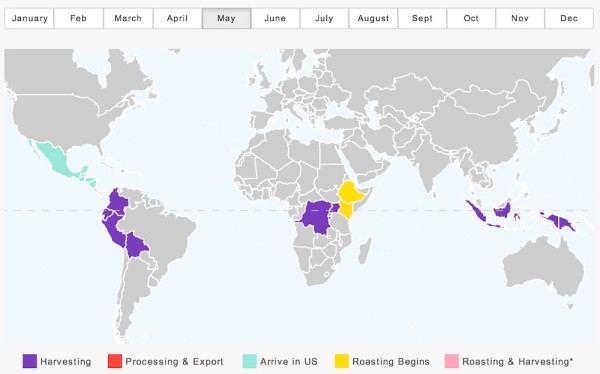
This screenshot (see link below for the interactive map) shows approximate lifecycle statuses for May.
Well, this is fun.
Counter Culture Coffee, which months ago gave us the gift of this greatly expanded Taster’s Flavor Wheel, now presents a lightly interactive coffee seasonality map. The color-coded map shows approximate monthly dates for the coffee lifecycle — harvesting, processing and export, U.S. arrival and roasting — for each producer country Counter Culture deals in. (Side note: a pink color represents harvesting and roasting, for when a country’s harvest overlaps with when its coffees are being roasted stateside.)
(related: Anodyne Among the Small Minority Investing in Real-Time Coffee Apps)
Counter Culture offers this appropriate caveat:
Please note that this map provides a general harvest calendar for each country based on many years of purchasing. There can be significant variation in the harvest, processing, and arrival of coffee. The size of the farm or cooperative, available infrastructure in the producing country, volume harvested, and environmental factors can impact when Counter Culture receives a specific coffee and when it is sold.
Unlike the flavor wheel, the map has little value as an industry tool, but it does seem to be part of a larger movement among specialty roasters to beat the related concepts of seasonality and origin into the heads of more conscientious consumers. Counter Culture introduces the map with the following, also including a seasonal availability list for a number of its coffees:
Coffee is at its best when treated like fresh produce. Understanding coffee as produce lets us think of it as a freshly crafted food, with all the delicious experience that brings.
The excitement of a new crop of coffee is one of the best parts of working in the coffee industry. But, as months go by, flavors fade, and the coffee loses its unique characteristics, becoming more and more ordinary. Luckily, by then, the seasons will have changed, and there will be new harvests of new coffees to explore and enjoy.
Explore and enjoy, indeed.
(related: Counter Culture Buyers Ionescu and Hill on a ‘Coalescing’ Direct-Trade Philosophy)
Nick Brown
Nick Brown is the editor of Daily Coffee News by Roast Magazine.
Comment
2 Comments
Comments are closed.






Great! But you forgot Brazil, the largest producer of arabica coffee in the planet.
What happened to Brazil, Indonesia, India and the rest?